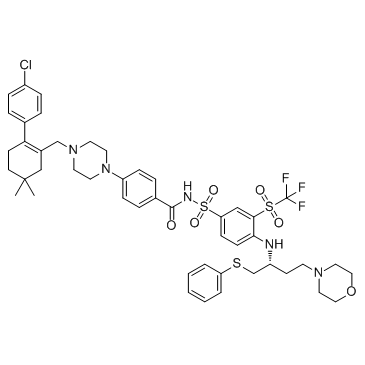923564-51-6
| Name | Navitoclax |
|---|---|
| Synonyms |
4-(4-{[2-(4-Chlorophenyl)-5,5-dimethyl-1-cyclohexen-1-yl]methyl}-1-piperazinyl)-N-[(4-{[(2R)-4-(4-morpholinyl)-1-(phenylsulfanyl)-2-butanyl]amino}-3-[(trifluoromethyl)sulfonyl]phenyl)sulfonyl]benzamide
Navitoclax Benzamide, 4-[4-[[2-(4-chlorophenyl)-5,5-dimethyl-1-cyclohexen-1-yl]methyl]-1-piperazinyl]-N-[[4-[[(1R)-3-(4-morpholinyl)-1-[(phenylthio)methyl]propyl]amino]-3-[(trifluoromethyl)sulfonyl]phenyl]sulfonyl]- ABT263 4-[4-[[2-(4-chlorophenyl)-5,5-dimethylcyclohexen-1-yl]methyl]piperazin-1-yl]-N-[4-[[(2R)-4-morpholin-4-yl-1-phenylsulfanylbutan-2-yl]amino]-3-(trifluoromethylsulfonyl)phenyl]sulfonylbenzamide (R)-4-(4-((4'-chloro-4,4-dimethyl-3,4,5,6-tetrahydro-[1,1'-biphenyl]-2-yl)methyl)piperazin-1-yl)-N-((4-((4-morpholino-1-(phenylthio)butan-2-yl)amino)-3-((trifluoromethyl)sulfonyl)phenyl)sulfonyl)benzamide 4-[4-[[2-(4-Chlorophenyl)-5,5-dimethyl-1-cyclohexen-1-yl]methyl]-1-piperazinyl]-N-[[4-[[(1R)-3-(4-morpholinyl)-1-[(phenylthio)methyl]propyl]amino]-3-[(trifluoromethyl)sulfonyl]phenyl]sulfonyl]benzamide ABT-263 |
| Description | Navitoclax (ABT-263) is a potent and oral Bcl-2 family protein inhibitor that binds to multiple anti-apoptotic Bcl-2 family proteins, such as Bcl-xL, Bcl-2 and Bcl-w, with a Ki of less than 1 nM. |
|---|---|
| Related Catalog | |
| Target |
Bcl-W:1 nM (Ki) Bcl-xL:1 nM (Ki) Bcl-2:1 nM (Ki) |
| In Vitro | Navitoclax (ABT-263) is active against approximately one-half of the cell lines of the PPTP in vitro panel. The median IC50 for all of the lines in the panel is 1.91 µM[1]. Navitoclax in combination with chemotherapy agents leads most ovarian cancer cell lines a synergistic response, and enhances the caspase activation at all paclitaxel doses tested in both SK-OV-3 and IGROV-1 cell lines[2]. |
| In Vivo | Navitoclax (100 mg/kg/day, p.o.) also improves responses to bendamustine-rituximab (BR) in a subset of tumours in mice xenograft[3]. |
| Kinase Assay | To measure caspase-3/7 activation, IGROV-1 and SKOV3 cells are seeded in 96-well plates at 5,000 cells per well. After 24 hours, cells are treated with navitoclax (1 μM), paclitaxel (dose range=1-100 nM), or in combination with navitoclax and paclitaxel using the same dosing concentrations. Each treatment is done in duplicate wells. Induction of apoptosis, following treatment at time 0, 4, 24, and 48 hours, is determined using a Caspase-Glo 3/7 assay. A DMSO control is included in all studies. The experiment is conducted twice, and the data are presented as an average of both runs. |
| Cell Assay | Cells are seeded in 384-well plates at 3,000 cells per well. After 24 hours, cells are treated with navitoclax (dose range of 14 nM-3.3 μM) and paclitaxel (dose range of 15 pM-100 nM) or gemcitabine (dose range of 0.5 nM-3.3 μM) in a 9 by 7 matrix. Each treatment is carried out in quadruplicate. Cells are treated for 72 hours, and cell viability is determined using the CellTiter-Glo assay. Cell viability for each treatment is normalized against the DMSO control group. |
| Animal Admin | For systemic Granta 519 tumour models, 2×106 cells are injected via the tail vein in 0.1 mL volume of cell medium on day 0, and treatment is initiated on day 14. All animals are ear-tagged and monitored individually throughout the experiment. Navitoclax is administered by oral gavage once daily in a mixture of Phosal 50PG : PEG400 : ethanol. Bendamustine and rituximab are administered i.v. at 25 and 10 mg/kg, respectively, on day 1. Navitoclax is administered approximately 2 h before bendamustine and rituximab. All trials are comprised of 10 mice per group. Mice are humanely killed when tumours reached a size >2000 mm3 or when any signs of distress are monitored. Signs of distress include loss of ambulation, laboured breathing or weight loss > 20% mean body weight per cage. |
| References |
| Density | 1.4±0.1 g/cm3 |
|---|---|
| Melting Point | 114-116ºC |
| Molecular Formula | C47H55ClF3N5O6S3 |
| Molecular Weight | 974.613 |
| Exact Mass | 973.295532 |
| PSA | 170.42000 |
| LogP | 12.14 |
| Index of Refraction | 1.655 |
| Storage condition | -20°C Freezer, Under Inert Atmosphere |
| HS Code | 29339900 |
|---|
